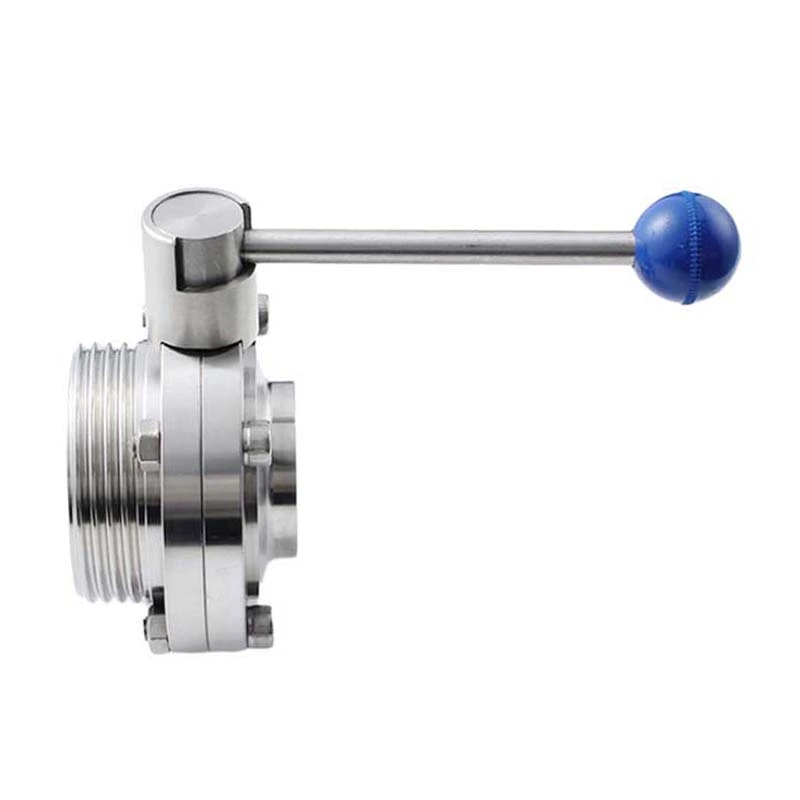Stainless Steel Butterfly Valves Still Have The Following Problems During Use
Sanitary Butterfly Valve, as the name implies, is a butterfly valve made of stainless steel to form a multi-layer metal hard seal structure. There are many types of models and it is widely used. Let me introduce the characteristics of stainless steel butterfly valves and some problems in their use.
Stainless steel butterfly valves, as a component used to realize the on-off and flow control of pipeline systems, have been widely used in many fields such as petroleum, chemical industry, metallurgy, hydropower, etc. In the known butterfly valve technology, its sealing form mostly adopts a sealing structure, and the sealing material is rubber, polytetrafluoroethylene, etc. Due to the limitation of structural characteristics, it is not suitable for industries such as high temperature resistance, high pressure resistance, corrosion resistance, and wear resistance. A relatively common butterfly valve is a three-eccentric metal hard seal butterfly valve, in which the valve body and valve seat are connected components, and the valve seat sealing surface layer is welded with heat-resistant and corrosion-resistant alloy materials. The multi-layer soft stacking seal ring is fixed on the valve plate. Compared with the traditional butterfly valve, this butterfly valve has the advantages of high temperature resistance, easy operation, no friction when opening and closing, and the seal is compensated as the torque of the transmission mechanism increases when closing, which improves the sealing performance of the butterfly valve and prolongs its service life.
However, this stainless steel butterfly valve still has the following problems during use:
1. Since the multi-layer soft and hard stacked sealing ring is fixed on the valve plate, when the valve plate is normally open, the medium forms a positive scouring on its sealing surface. After the soft sealing belt in the metal sheet interlayer is scoured, it directly affects the sealing performance.
2. Due to the limitation of structural conditions, this structure is not suitable for valves with a diameter below DN200, because the overall structure of the valve plate is too thick and the flow resistance is large.
3. Due to the principle of the three-eccentric structure, the seal between the sealing surface of the valve plate and the valve seat is pressed against the valve seat by the torque of the transmission device. In the positive flow state, the higher the medium pressure, the tighter the seal squeeze. When the unit positive pressure between the valve plate and the valve seat is less than the medium pressure as the medium pressure increases during the reverse flow of the flow channel medium, the seal begins to leak.
High-performance three-eccentric bidirectional hard-sealed stainless steel butterfly valve, characterized in that: the valve seat sealing ring is composed of multiple layers of stainless steel sheets on both sides of the soft T-shaped sealing ring.
The sealing surface of the valve plate and the valve seat is an oblique cone structure, and the oblique cone surface of the valve plate is welded with heat-resistant and corrosion-resistant alloy materials; the spring fixed between the adjusting ring pressure plate and the adjusting bolt on the pressure plate are assembled together. This structure effectively compensates for the tolerance band between the shaft sleeve and the valve body and the elastic deformation of the valve stem under the medium pressure, and solves the sealing problem of the valve in the process of two-way interchangeable medium transportation.
The sealing ring is composed of soft T-shaped multi-layer stainless steel sheets on both sides, which has the dual advantages of metal hard sealing and soft sealing, and has zero leakage sealing performance regardless of low temperature and high temperature. The test shows that in the positive flow state of the pool (the flow direction of the medium is the same as the rotation direction of the butterfly plate), the pressure on the sealing surface is generated by the torque of the transmission device and the effect of the medium pressure on the valve plate. When the positive medium pressure increases, the tighter the oblique cone surface of the valve plate and the sealing surface of the valve seat are squeezed, the better the sealing effect.
When in the countercurrent state, the seal between the valve plate and the valve seat is pressed against the valve seat by the torque of the driving device. As the reverse medium pressure increases, when the unit positive pressure between the valve plate and the valve seat is less than the medium pressure, the deformation energy stored in the spring of the regulating ring after being loaded can compensate for the tight pressure between the valve plate and the valve seat sealing surface and play an automatic compensation role.
Therefore, unlike the existing technology, the utility model does not install a soft and hard multi-layer sealing ring on the valve plate, but is directly installed on the valve body. Adding an adjusting ring between the pressure plate and the valve seat is an ideal two-way hard sealing method. It will replace gate valves, stop valves and ball valves. This type of valve should generally be installed horizontally in the pipeline.
